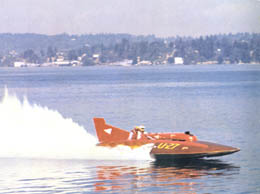On October 1, 1949, the hydroplane, a racing boat that used aerodynamic principles to ride above the water instead of through it, is successfully tested for the first time on Lake Washington. The hydroplane's team is Ted Jones, a Boeing engineer; Anchor Jensen, a boat builder; and auto dealer Stan Sayres (1896-1956).
Jones, an amateur boat builder, began experimenting with hull designs in the 1920s because he lacked the money for larger engines to make his boats go faster. By 1934, he had developed a three-point hydroplane and although it was "just fast as hell" (Woog), it was unstable. In the late 1940s, Jones partnered with auto dealer and racing-boat driver Stan Sayres to build a racing boat and Sayres recruited Lake Union boat builder Anchor Jensen (1918-2000) to the effort. They first built Slo-Mo-Shun III and then the more successful Slo-Mo-Shun IV.
While Slo-Mo-Shun IV was being tested from 1948 to 1950, it was nicknamed "The Hunts Point Ferry" because it was seen crossing Lake Washington repeatedly. In 1950, the boat set a world speed record of more than 165 miles per hour at the Gold Cup Races in Detroit.
Slo-Mo-Shun IV maintained its winning streak through 1954 when it brought hydroplane racing to Seattle. According to Seattle hydroplane fanatic Paul Lowney, Slo-mo IV "made Seattle hydroplane-conscious and turned half the population of the city into unlimited hydroplane enthusiasts and fanatics." The Gold Cup race became the centerpiece of Seattle's annual Seafair celebration.
As of 2000, Slo-Mo-Shun IV was owned by Seattle's Museum of History and Industry.

